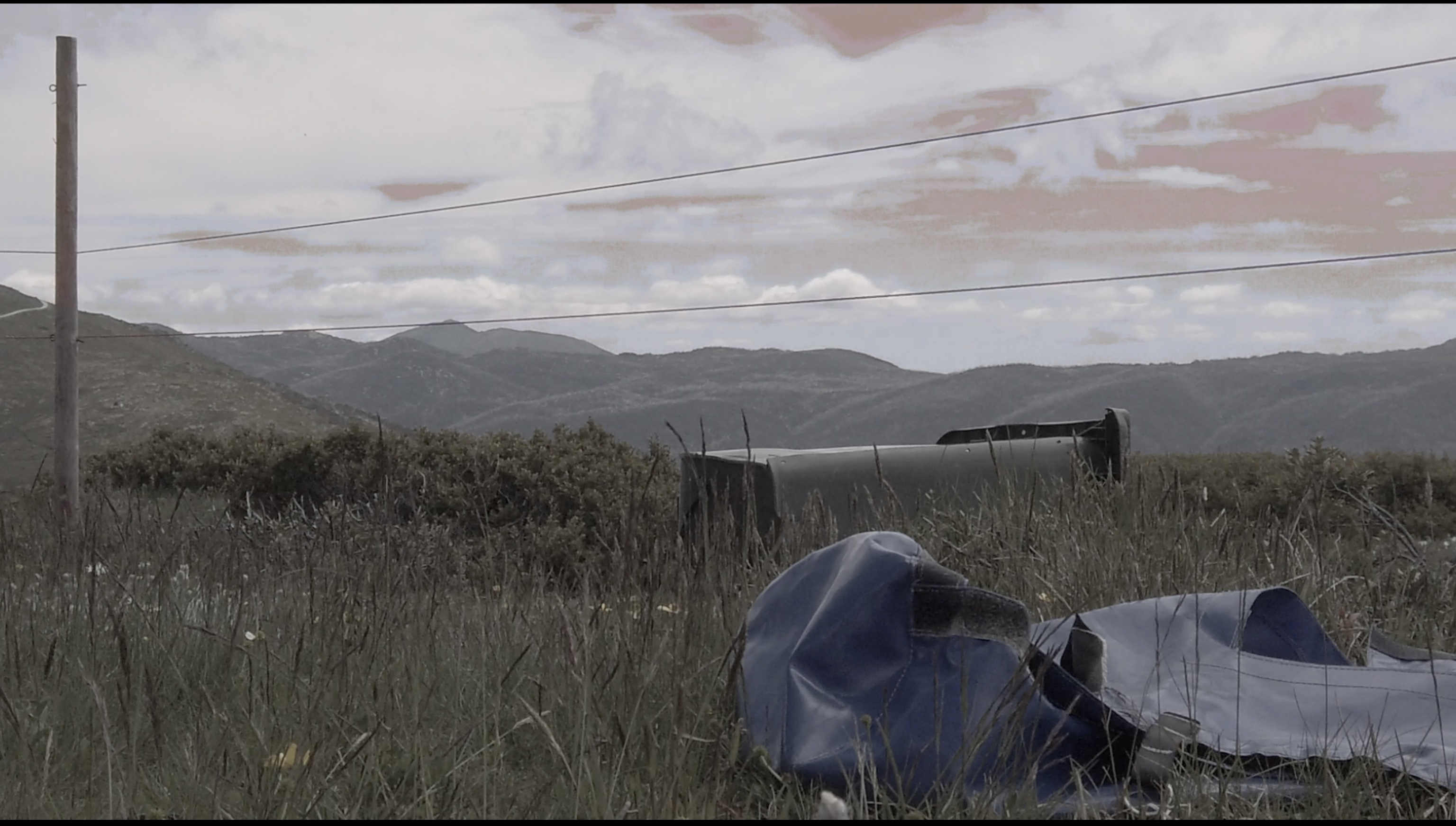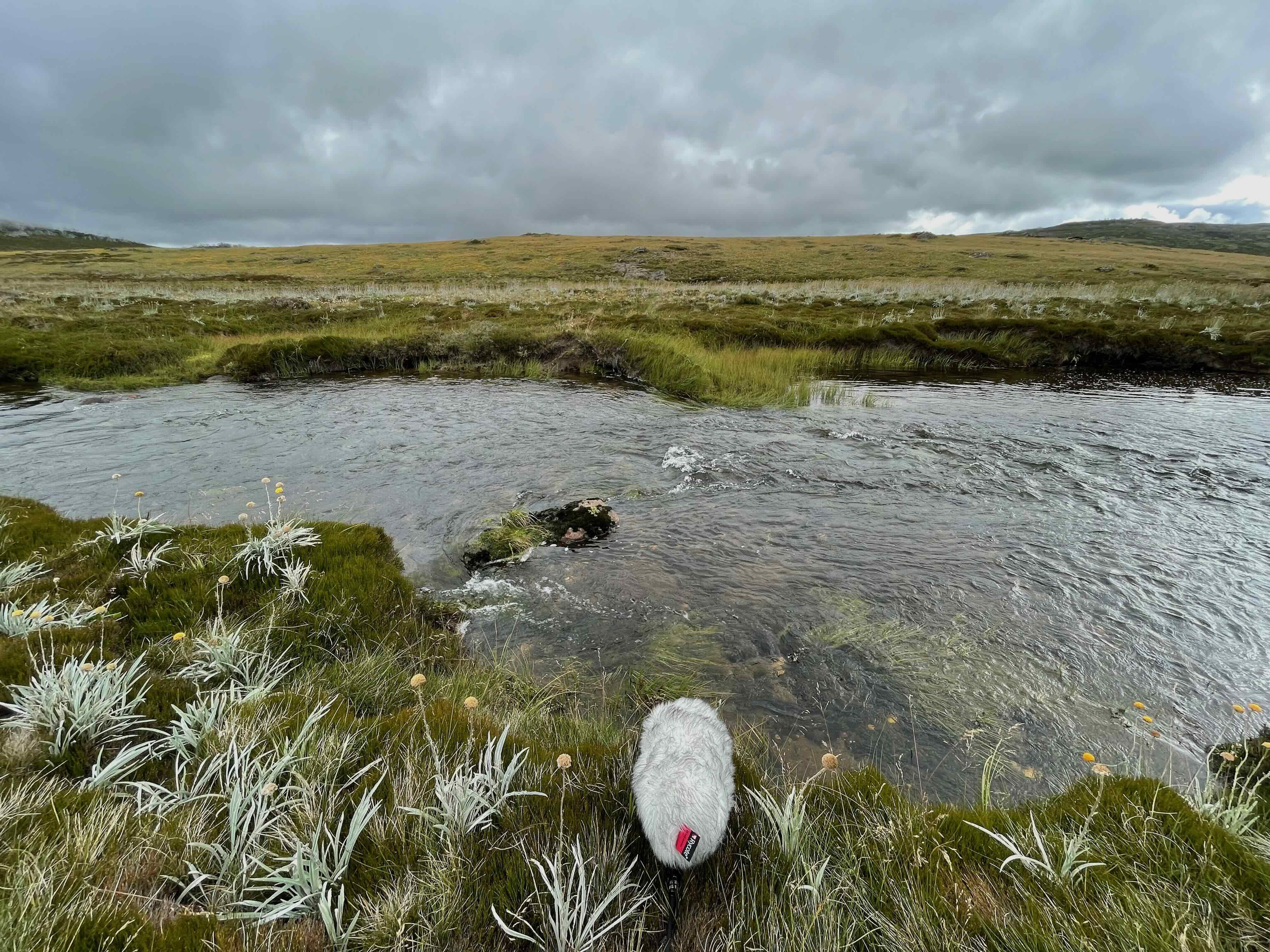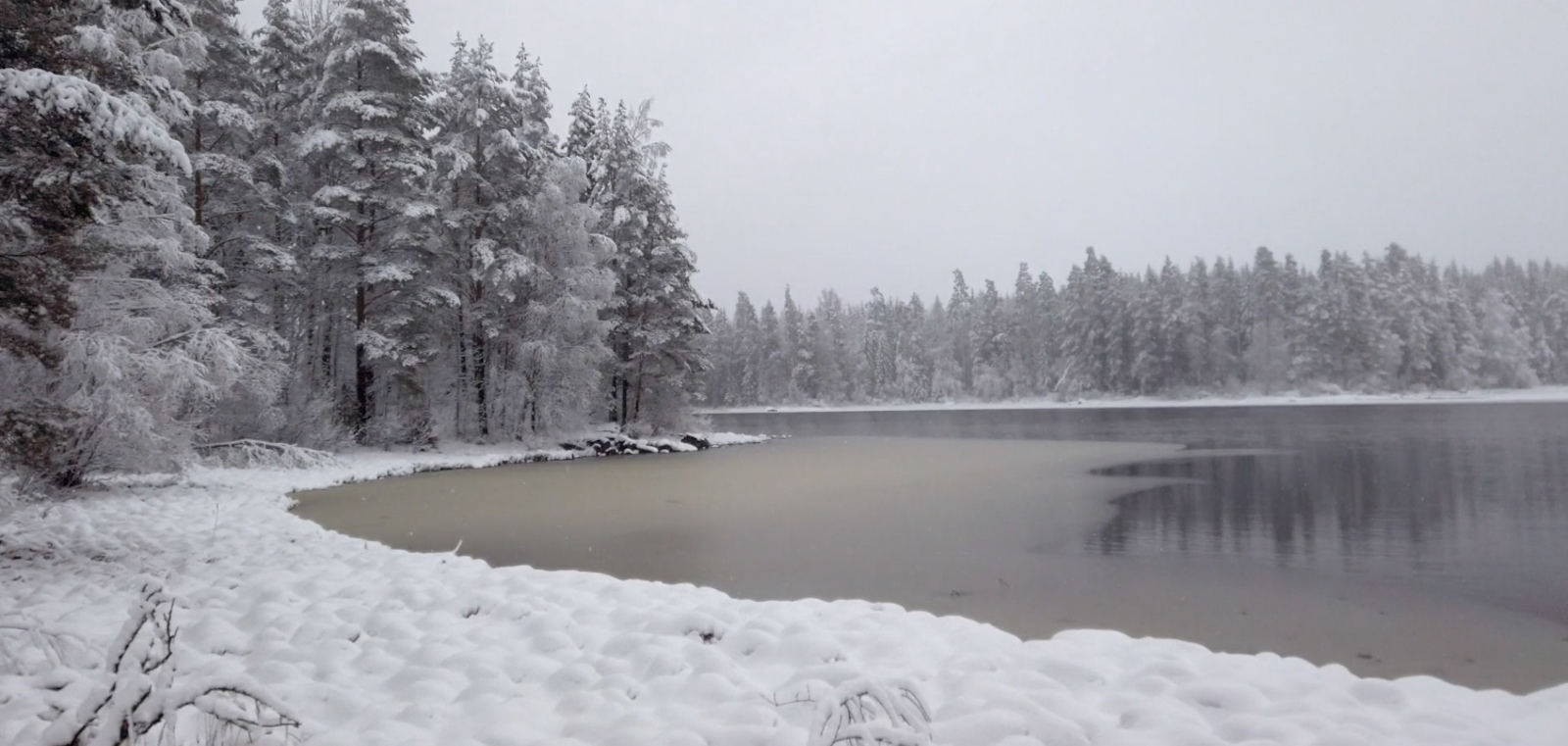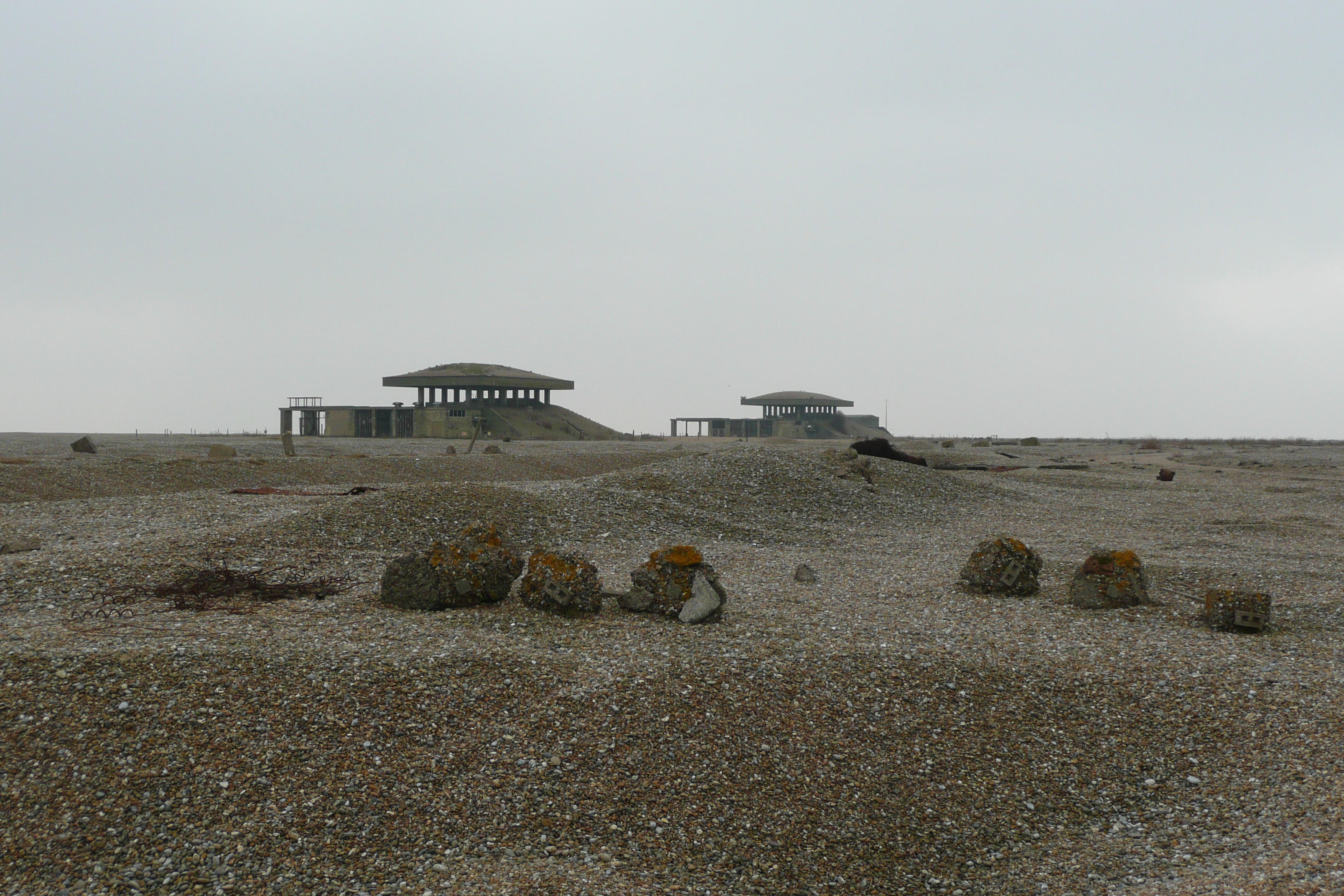Projects 26
Bogong High Plains Sound Map
The Bogong High Plains Sound Map comprises field recordings documenting the eco-acoustic characteristics of the Bogong High Plains and Kiewa Valley to register the effects of climate change, industrialisation, environmental dissonance, and recreational tourism upon this rarefied cold climate ecology. The website uses real time meteorological data to activate sound recordings that reflect prevailing atmospheric conditions. It also offers a variety of navigational pathways to encourage new and dynamic encounters with the archive.
Sound maps provide a way of expressing the acoustic markers of place distinct from the textual and visual methods used in traditional cartography. For this project sound recordings are used to expand the way the region is represented by incorporating seasonal characteristics, and material and social encounters to enhance user experience and interaction. The website features recordings produced over two years to demonstrate ways in which the alpine environment is transformed by climate and weather, and activities such as power generation, land management, tourism, and sport. It also uses field documentation and commissioned photography to identify spatial, environmental, and topographic features within the landscape. Through the convergence of natural, anthropogenic, and atmospheric events the sound map articulates the operations and tensions underpinning this uniquely Australian cold climate ecology.
The recent wildfires in Victoria and New South Wales, and prolonged closure of the Bogong High Plains Road due to an unprecedented landslip, provide powerful evidence of the vulnerability of alpine habitats. This project is responsive to the volatility generated by global warming by preserving and advocating for a place central to the health and wellbeing of all Australians.
Click here to access the Sound Map
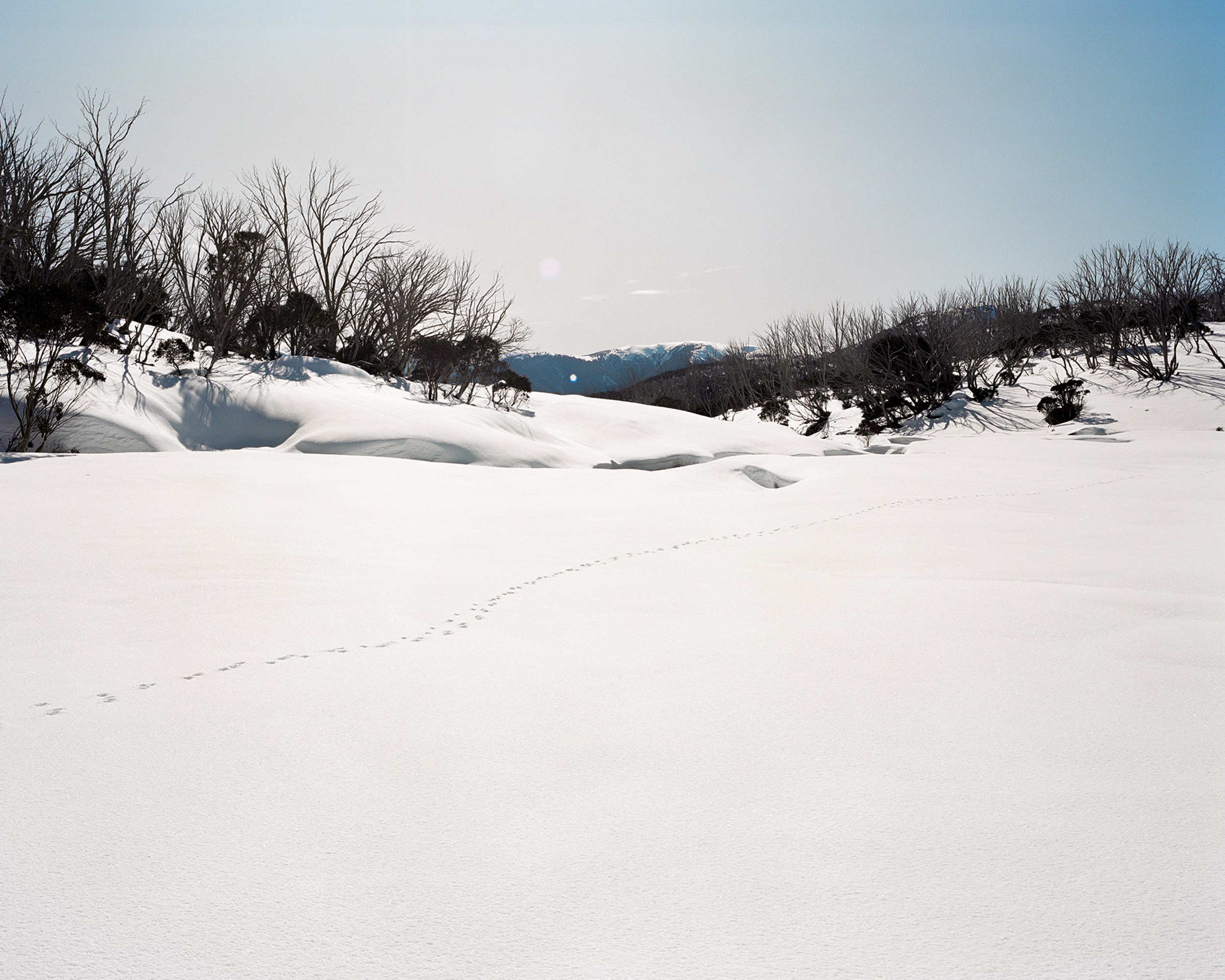
The Bogong High Plains Sound Map is supported by the Australia Council for the Arts, Regional Arts Victoria, and the Cold Climate Research Lab at the School of Art - RMIT University.
Now Flow Fast Slow: Exhibition
About
Now Flow Fast Slow is a video collage by conceptual artist Justas Pipinis interweaving still video portraits of past Bogong Village residents, guests and workers filmed in 2020-21 with a time-lapse video of the road trip from Melbourne to Bogong during the same period.
When
October 31 - November 30, 2025
Friday - Sunday
11.00am - 4pm
Location
B–CSC Gallery
Main Street
Bogong Village
Events
Saturday, November 1, 2025
ARTIST TALK: 1 - 2pm RSVP
OPENING CELEBRATION: 12 - 4 pm
Artist
Justas Pipinis is always busy making sense of the stuff that does not. He believes more in the constant flux than in fixed truths and is therefore more interested in open-ended explorations of the surrounding world and our ideas about it than production of resolved works. Each audience encounter is then an invitation to join the ride and compare the notes. It is in the gaps between the map and the territory, between different understandings of the same, that new insights and artistic experiences emerge.
Justas is the Founding Undirector of the Aimless Research Institute. He has recently completed a creative practice-based PhD at RMIT University School of Art. He holds an MFA with Distinction from RMIT and an MSc in Social Anthropology from Stockholm University. Having also studied at Konstfack, Umeå Academy of Fine Arts, KTH, the University of Vienna, Karlstad University and Vilnius University, he is a bit overeducated for his own good, and tries to stay real by doing silly things that challenge the best academic practice he has spent years to learn.
Look Both Ways Exhibition
This engaging exhibition reimagines how we perceive and experience the natural world. In Look Both Ways, acclaimed artist Lesley Duxbury employs a Black Mirror—an 18th-century optical tool once used by artists and travelers—to transform familiar landscapes into striking, contained reflections.
Each photograph centers on the mirror, resting among dried gum leaves or on rocks in flowing water, where it reframes the environment in unexpected ways. Captured from the perspective of an observer looking downward, these images invite a deeper contemplation of place, movement, and time.
Challenging the traditional notion of landscape as a distant vista, Look Both Ways offers an intimate, layered encounter—one shaped by perception and reflective observation. Don’t miss this thought-provoking exploration of how we see and document the natural world.
Dates + Time
February 28 - April 6, 2025
Friday - Sunday
10.30am - 4pm
Location
B–CSC Gallery
Main Street
Bogong Village
Events
ARTIST TALK
In Conversation with Lesley Duxbury
March 1, 2025
Saturday
1 - 2pm
Artist
Lesley Duxbury is an artist whose work explores perception, atmosphere, and the natural environment through photography, printmaking, and text. Her practice is rooted in extended walks through remote landscapes, where she documents fleeting atmospheric phenomena and shifting terrains. From the Arctic’s icy expanses to Australia’s high plains, these experiences inform her investigations into how we see and interpret place.
Duxbury’s work often employs text to shape and reframe visual narratives, inviting personal reflection and alternate readings of landscape. She has exhibited widely in Australia and internationally, with shows in Korea, Austria, and Hong Kong, and has participated in artist residencies in Iceland, Paris, and Western Australia. A recipient of the Australia Council’s New Work Grant, she is also an Emeritus Professor at RMIT University’s School of Art.
Snowmelt Transmission
Snowmelt Transmission is a site-specific audio work by Melbourne-based artist Benton Ching.
Showtimes: Monday to Friday, 5.30pm
Location: Bogong Village Public Phone Box
Runtime: Approximately 5 Minutes
Credits: Composed by Benton Ching
Narrated by Emma Payne
Made with additional recordings from the Bogong High Plains Sound Map.
The piece is composed of field recordings taken in the high country by the artist during his residency at the Bogong Centre for Sound Culture in April 2024, alongside recordings from the Bogong High Plains Sound Map – a digital repository of sounds from the high plains created by the Bogong Centre for Sound Culture.
Climate modelling scenarios ominously predict the number of snowy days in alpine Australia plummeting in decades to come, with this having drastic knock-on effects on ecology and human life in the region. The piece takes the form of a call to this local payphone from an undisclosed future time, when these effects have been irreversibly set in motion. It serves as an ode to the local landscape, tracing the contours of the Victorian Alps through sound – following the flow of water as it turns from snow, to stream, to fall and its eventual conversion to electricity as it carves through the high country.
This work was made on unceded Jaithmathang country with additional recordings from Bidawal, Dhuduroa, Gunai/Kurnai, Mitambuta, Monero-Ngarigo and Taungurung country.
We acknowledge and pay our respects to their elders past and present.
The Bogong Symphony
In July 2019, researcher and curator Leandro Pisano and multidisciplinary artist Daniela d'Arielli visited for the first time the village of Bogong, located in the heart of the Alpine National Park in Australia. During this visit, planned as part of a residency project organised by the BCSC and curated by Philip Samartzis and Madelynne Cornish, the two experience the passage through scattered rural settlements, forests and waterways marked by the massive presence of hydroelectric power stations. Built in the 1930s and 1940s by the State Electricity Commission (S.E.C.) for workers and their families during the construction of the Kiewa Hydroelectric Project, Bogong is surrounded by dense forests and is home to four hydroelectric dams: Clover, West Kiewa, Mackay Creek and AGL Bogong, which power 122,000 homes, or 3% of Victoria's electricity grid.
"The Bogong Symphony" is the result of this experience and is an audio-visual work that combines field recording, voice and photography. Realised by Giuseppe Cordaro (sound design) and Leandro Pisano (field recording), with photography by Daniela d'Arielli, video editing by Alessandra Sanvito and vocals by Giada Maria Goglia, this project bears witness to the artistic residency undertaken by Pisano and d'Arielli in the Australian Alps in July 2019. Exactly five years after this journey, the artists explore and document through this work the traces and resonances of a journey to rethink the political ecology of rural and remote territories, challenging and expanding the very concept of 'rural' through unexpected and unpredictable approaches.
Supported by the Italian Institute of Culture in Melbourne
Click here for The Bogong Symphony.
Atmospheres and Disturbances
Atmospheres and Disturbances registers the changes in high altitude ecologies caused by increasing global temperatures. The composition is based on field work undertaken at the High-Altitude Research Station at Jungfraujoch, Switzerland where for four weeks I deployed various recording devices around the station, and in the surrounding alpine environment to register natural, anthropogenic and geophysical forces. The project provides new encounters of an endangered alpine environment to enhance the way we perceive and engage with notions of place, community, and environmental dissonance.
During fieldwork I used different microphones to record a variety of acoustic, spatial, atmospheric, and vibration-based phenomena. Omnidirectional microphones registered wind, snow, and ice as well as social, material, and industrial sound emanating from the nearby train terminus and viewing platforms. Hydrophones were placed within water and ice to record geophysical sound resonating within the frozen environment of Jungfraujoch and the adjacent glacier. The recordings capture the pervasive presence of anthropogenic sound permeating throughout the landscape produced by tourists, transport operations and recreational sports. Accelerometers were attached to various surfaces and structures to record solid vibration generated by high-velocity wind, and the process of melting and freezing. The recordings produced by the accelerometers clearly express the stress and fatigue occurring within the material structure of buildings and infrastructure.
Atmospheres and Disturbances is designed to place audiences deep inside an extreme environment to afford embodied experiences of an alpine ecology under duress.
This project is supported by the Bogong Centre for Sound Culture, Creative Victoria, the High Altitude Research Station at Jungfraujoch, the Institute for Computer Music and Sound Technology at the Zurich University of the Arts, RMIT School of Art, and the Swiss National Science Foundation.
Atmospheres and Disturbances CD / Booklet
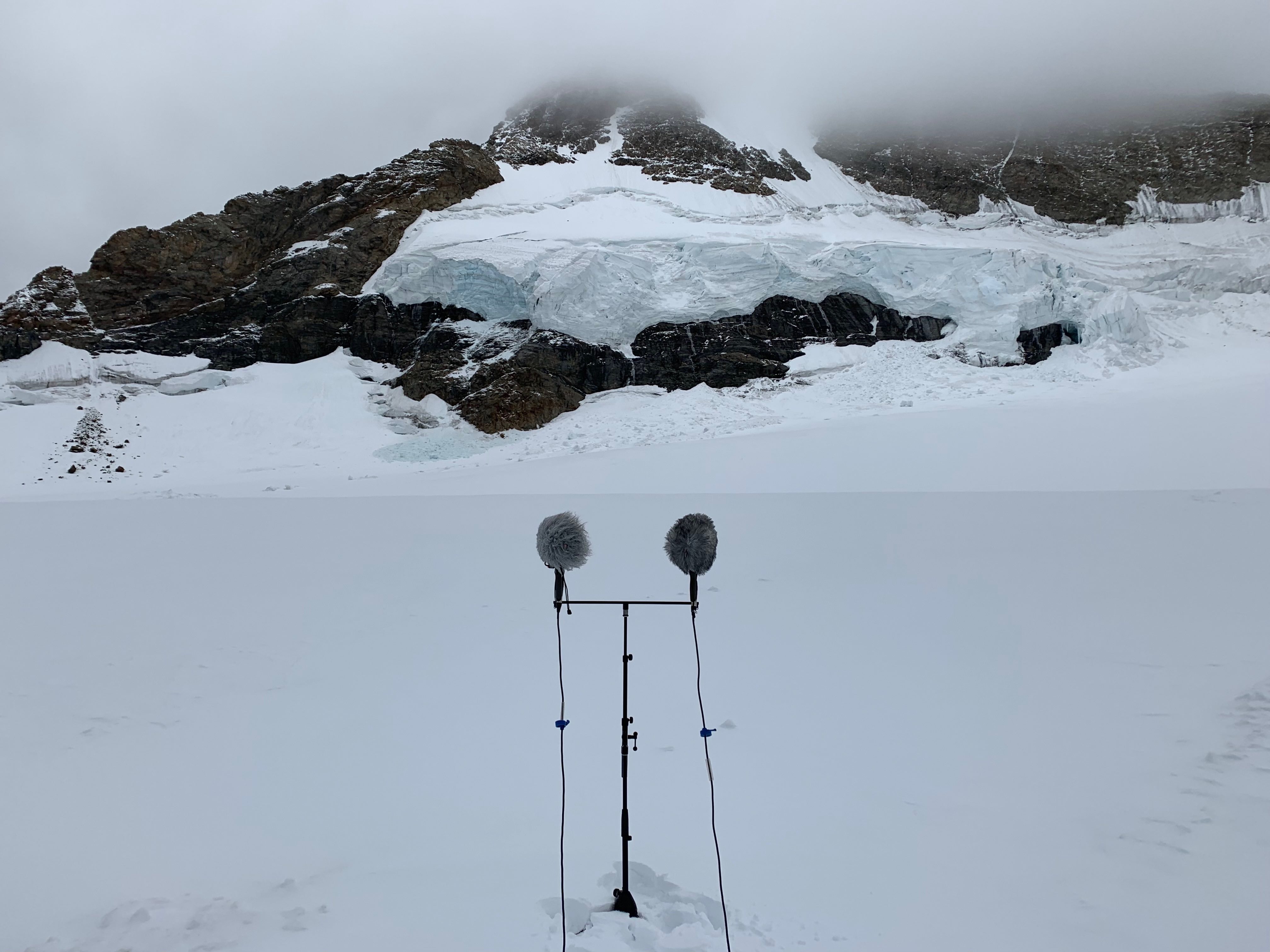
This is what the changing Alps sound like - SWI swissinfo
Polar Force

Polar Force at the Now or Never Festival - Melbourne
Polar Force is an immersive live performance by Speak Percussion combining custom built ice and wind instruments with Antarctic field recordings, set within a chilled inflatable performance space. This visceral and multi-sensorial work immerses audiences within an overwhelming sound world and performance environment. Newly designed ice-instruments are used to produce unique acoustic results, distorting as they melt and fracture to render ice into audible phenomena. High fidelity field recordings made in the Australian Antarctic Territory of katabatic winds and extreme weather events form the musical and structural foundation of the work. Philip Samartzis drew upon hundreds of hours of recordings he made during his two Australian Antarctic Arts Fellowships to underpin the work. Some of the recordings were made using an array of digital recorders placed throughout Casey Station during a 100 knot blizzard. Sounds of sea ice, icebergs and glaciers also feature in the performance. The field recordings are used to form a series of multichannel environments to provide audiences with vivid and tactile experiences of the natural, anthropogenic and geophysical forces shaping the frozen continent. Polar Force references climate change and global geopolitical tension including the exploration and exploitation of frontier territories.
Polar Force is the recipient of an Honorary Mention for the Digital Musics and Sound Art Category in the 2019 edition of the Prix Ars Electronica.
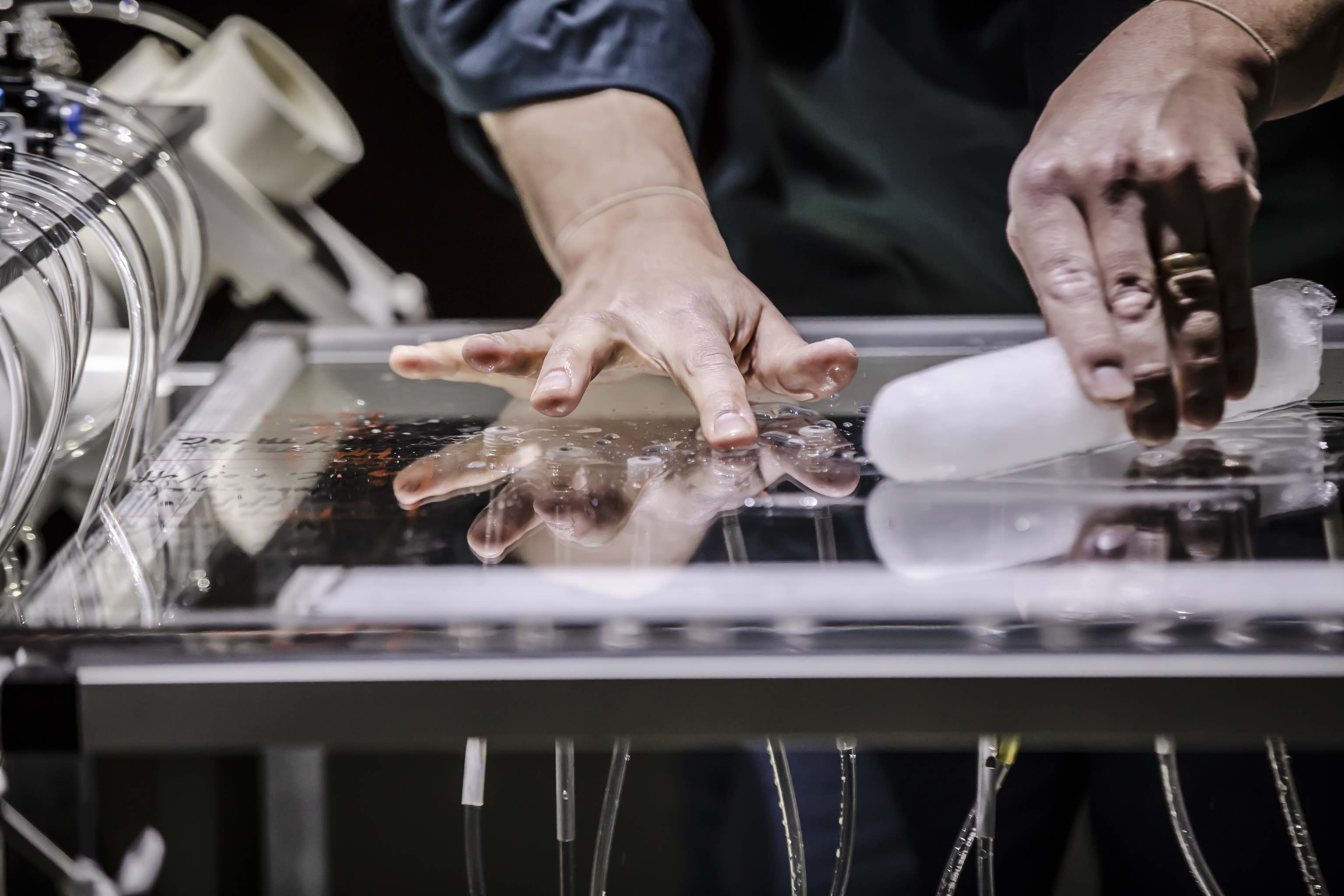
Polar Force is supported by the Australian Antarctic Division, Australia Council for the Arts, Creative Victoria, City of Melbourne, Benson Family Foundation, and the School of Art at RMIT University
Click here for interview with Clot Magazine
Between Two Sites
News! Between Two Sites wins the 2024 Victorian Museums and Galleries Award for Small Project of the Year (Gallery)
Star Mail News Awards interview – burrinja-and-bogong-centre-for-sound-culture-celebrate-award-for-innovative-environmental-exhibition.pdf
About
The Between Two Sites exhibition and public programs respond to the impact of human activity on habitats in the Yarra Ranges and Alpine Shire. Curated by Madelynne Cornish and Sarah Lynch for the Bogong Centre for Sound Culture. It showcases the artwork of Victorian and international artists who participated in the centre's residency program. These artists have undertaken extensive fieldwork within the Yarra Ranges, Alpine National Park and Kiewa Valley. They have produced a new range of site-specific artworks that comprise a rich and diverse set of environmental references to deepen our understanding of these places. Artists have used audio-visual installation, photography and sound composition to reflect the ecology of these regions.
Artists: Anne McCallum, Madelynne Cornish, Sarah Lynch, Shannon Collis, Lesley Duxbury, Sarah Edwards &
Amias Hanley
exhibition-catalogue.pdf essay author Prudence Gibson
Burrinja Cultural Centre
Dates + Times:
May 27 – July 1, 2023
Wednesday – Saturday
10am – 4pm
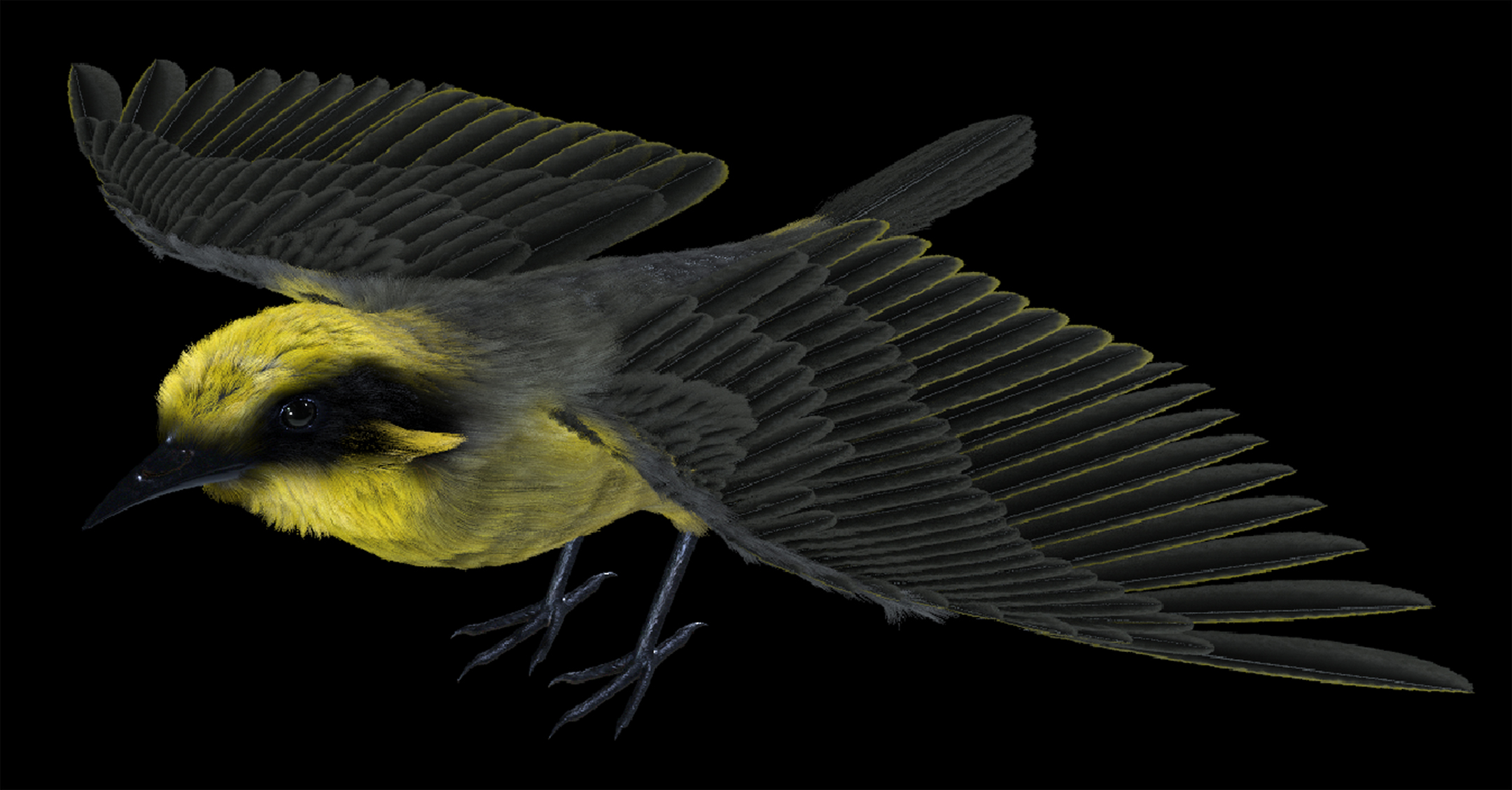
Public Programs
Exhibition Launch: Saturday 27th of May @ 2pm
Between Two Sites Artist Round Table: Sat, 3 Jun 2 to 4pm:
Twining Workshop Presented by Anne McCallum: Sat, June 10, 1-3pm
Yellingbo Nature Conservation Reserve - An Immersive Listening Experience: Sat June 17, 1-2.30pm
Children's Activities: Build a nest with Friends of the Helmeted Honeyeater: Thurs, June 29th, 10.30 to 2.30pm [suitable for 3 -12 year olds]
Address
Burrinja Cultural Centre
Wurundjeri Country,
351 Glenfern Rd,
Upwey, Victoria,
3158, Australia
Contact
Phone: (03) 9754 8723
Audio Described

Between Two Sites exhibition has been made accessible to blind and low vision communities through audio description available in audio and text formats on our dedicated website between-two-sites.com - Audio Described and via printed QR code posters displayed throughout the gallery at Burrinja.
Please go to between-two-sites.com - Audio Described to learn more about how to use the site, including accessibility at Burrinja, and to access the complete index of audio described works, or the following shortcuts below:
Ecotone: Anne McCallum
I Once Heard a Bird Sing: Madelynne Cornish
Above the Snow Line triptych 1: Sarah Lynch
Above the Snow Line triptych 2: Sarah Lynch
Kiewa: Shannon Leah Collis
Look Both Ways no1: Lesley Duxbury
Untitled 1 - 6: Lesley Duxbury
Between Heaven and Earth: Sarah Edwards
Ground Cover: Sarah Edwards
Junction Re-Sonant: Amias Hanley
Audio Description is a key access tool enabling people who are blind, or have low vision to equitably access arts and culture and can also benefit people with multisensory and learning disabilities, neurodiversity and Autism.
Audio description has been provided by Vitae Veritas a major provider of high quality audio description and tactile tour services for the performing and visual arts creative industries across metro and regional Victoria.
Funders

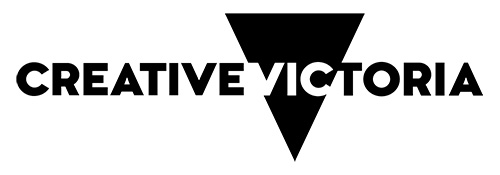

Unclear Cloud
Unclear Cloud is an architectural and sound installation by Roland Snooks and Philip Samartzis that draws attention to the scale, accelerating growth and subsequent ecological implications of computation and ‘the cloud’ – a metaphor for the internet. The project features in Sampling the Future at the NGV Australia.
Often thought of as immaterial and benign, the cloud is in fact a vast ecosystem of over 40 billion devices, apps and software, driving trillions of uploads, downloads and their subsequent storage. The seemingly non-physical contents of the cloud have a massive physical footprint on earth. The global network of energy-hungry data centres enabling the cloud are set to consume as much as 1/5 of the earth’s energy generation by 2025, much of it from non-renewable sources such as oil, gas and coal.
Unclear Cloud seeks to draw this complex scenario into focus, questioning how we feel about the most sophisticated technologies in use today – software, AI and algorithms being powered by polluting carbon-based systems that are contributing to global heating and its consequences. Our future cities will increasingly rely on advanced cloud computing, from simple algorithmic procedures to artificial intelligence, for their design, construction and infrastructural logistics. These cloud-based algorithms become the unseen structural framework behind the evolution of urbanism and architecture. Cloud Affects explores what is not seen in this algorithmically driven computational cloud world.
The project attempts to reify a structure from the nebulous; to materialise and express these intangible algorithms and make reference to the real-world infrastructure required to prop up the virtual cloud. It seeks to offer a new architectural geometric expression, one that can only emerge from the use of advanced computation within both the design and robotic fabrication processes.
Unclear Cloud also explores the architectural relationship of structure and ornament enabled by cloud-based algorithms. The polymer skin of the project is reinforced through the use of carbon fibre and resin to give it structural rigidity and strength. This carbon fibre inlay is simultaneously expressive and ornamental, an enhanced tectonic legibility of the structural system highlighting the algorithm-enabled architecture of the installation.
The embedded sound installation explores the environmental impact of cloud computing and its massive energy requirements – capturing the sounds of the cloud and its physical implications, being composed in part from recordings of glacial melting recorded in the Swiss Alps and Antarctica, and the scientific instruments used to measure greenhouse gases in the atmosphere – creating a sonic affect as a consequence of global climate change.
--
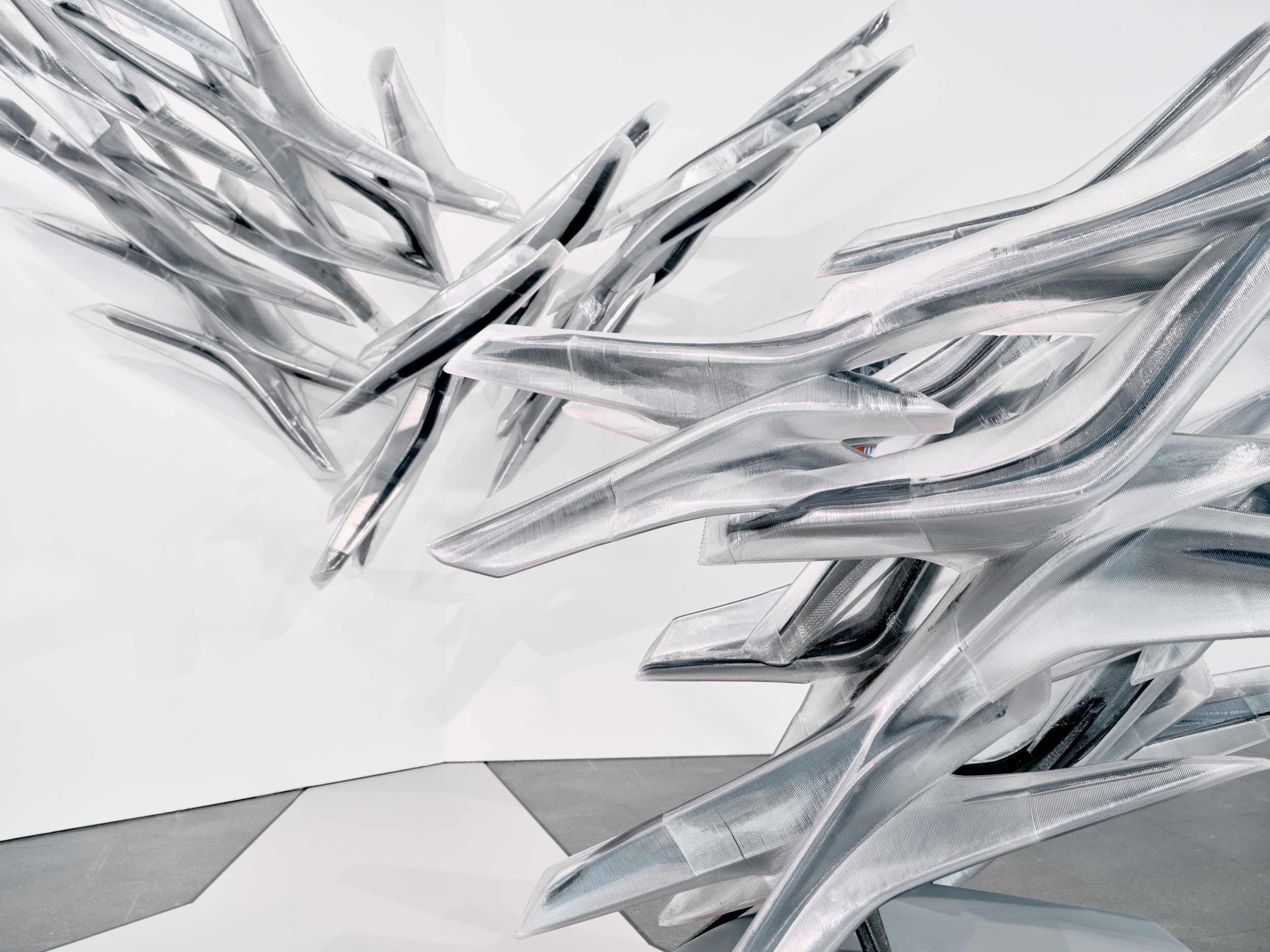
Commissioned by the Shenzhen Bi-City Biennale of Urbanism\Architecture and the National Gallery of Victoria, Melbourne with the support of RMIT University School of Architecture and Urban Design, RMIT University School of Art, Boeing, and The Hugh D. T. Williamson Foundation. Sound work supported by The Bogong Centre for Sound Culture, Creative Victoria, the High-Altitude Research Station at Jungfraujoch and Gornegrat, the Institute for Computer Music and Sound Technology at the Zurich University of the Arts, and the Swiss National Science Foundation.
This is what the changing Alps sound like - SWI swissinfo
Making Unclear Cloud - NGV Magazine
Notes from the field
Notes from the Field is first a portrait of a place – Bogong Village, in the Alpine region of North East Victoria. Bogong is a place of exceptional natural beauty, and a site of many intersecting concerns. Halfway between Mount Beauty and Falls Creek, it was established in its current form as a worker’s village for the Kiewa Hydroelectric scheme.
Bogong is the Dhudhuroa word for “big moth” and gives name to Mount Bogong, the Bogong High Plains and Bogong Village, as well as the well-known moth whose existence is now threatened through industrial agriculture, habitat destruction, climate change and other anthropogenic impacts. The discordant relationships between industrial technologies, human involvement and the environment is stark in the unique setting of Bogong Village. The power station is a major presence in the village, and although hydroelectric technology promises to produce green energy, the damming of the Kiewa river has forever altered the valley’s ecosystem and landscape.
It is in this environment that Madelynne Cornish and Philip Samartzis have been running the Bogong Centre for Sound Culture for the last ten years. The centre invites artists from across the globe to travel to this remote part of Australia and immerse themselves in the site. The artists mainly engage in fieldwork, a process of recording, compiling and organising information, such as sound, video, photographs, and sketches.
Notes from the Field brings together the work of 15 artists who have been resident at Bogong Village over the last ten years, with work presented both in the gallery spaces and online. Notes from the Field celebrates the incredible initiative of this globally reaching and supportive artist residency program in North East Victoria. The artists have observed and recorded the dissonance between landscape, humans and technology and now present their findings for us to consider.
Michael Moran, Curator
Murray Art Museum Albury
Click here for the online version of the exhibition.
The Manifesto of Rural Futurism
The Manifesto of Rural Futurism is a transnational project interrogating current discourses on rurality as authentic, utopic, anachronistic, provincial, traditional and stable, and the binaries that support such discourses: belonging vs. alienation, development vs. backwardness. A critical approach to rurality is necessary, today more than ever, to imagine other futures for rural communities, territories and places beyond the “otherness” vs. “identity” dichotomy. This exhibition attempts to understand rural areas as complex spaces actively immersed in the dynamism of encounters, flows and fluxes of contemporary geographies, and critically question modern discourses of capitalism and metropolitanism in which rural territories are marginalised and considered as doomed to oblivion.
The Manifesto of Rural Futurism is an invitation to experience rural locations and abandoned places as spaces in which to question our approach to history and landscape, our sense of living in a specific place and the relationship that we have with it. The sound of environments, spaces and landscapes reveal the challenges and territorial transformations that inform the ideology, infrastructure and biological ecosystems to which we form a part. In this sense, listening practices are deployed as a way to critically traverse the “border territories” of rural territories, challenging persisting notions about “inescapable marginality”, “residuality” and “peripherality”.
The Manifesto of Rural Futurism comprises sound and visual recordings by artists undertaking fieldwork in Southern Italy including: Daniela d’Arielli, Enrico Ascoli, Luca Buoninfante, Jo Burzynska, Enrico Coniglio, Alejandro Cornejo Montibeller, Nicola Di Croce, Fernando Godoy, Miguel Isaza, Raffaele Mariconte, Marco Messina, Mollin + Voegelin, Alyssa Moxley, Philip Samartzis, Vacuamoenia, David Vélez and Sarah Waring.
Curatorium: Daniela d’Arielli, Beatrice Ferrara, Leandro Pisano and Philip Samartzis

The Manifesto of Rural Futurism is supported by the Bogong Centre for Sound Culture, Liminaria/Interferenze new arts festival, Pollinaria, and the Contemporary Art and Social Transformation research group at the RMIT School of Art.
Click here for full program including compositions
A Futurist's Cookbook
This project emerges from a one-week residency I undertook at Pollinaria, a sprawling farm located at the base of Gran Sasso National Park in Abruzzo. The residency coincided with the summer harvest providing an opportunity for a variety of sound recordings of agricultural infrastructure, including complex machinery used to transform unrefined crops into processed foods. Most of the fieldwork was undertaken in the company of Daniela d’Arielli who navigated the winding and undulating topography while I searched for sounds residing in the dry pastoral landscape. During our field trips Daniela would photograph the places, objects and people we encountered. Often embedded in the landscape, hidden from view, shooting from a distance with a macro lens. The images accompanying the composition are designed to reveal the richly textured environments in which we worked.
The title A Futurist’s Cookbook is a reference to the provocative manifesto The Futurist Cookbook written by Filippo Tommaso Marinetti, circa 1932 – a treatise that drew on food as a raw material for art and cultural commentary. Marinetti’s clever use of the cookbook format to advance collective artistic consciousness appeals to my sense of the absurd. In spite of the misogynist sentiments, perverse speculations and nationalist impulses, Marinetti’s musings provide shrewd observations of contemporary life. While the Futurists often privileged the urban as the bastion of technology, disruption and noise, the rural offers an equally complex soundscape of natural, geophysical and industrial sound. A Futurist’s Cookbook is an expression of the exuberant noise and dynamism permeating throughout the countryside. One as thrilling and sensual as anything the discordant city can utter. It is also an affectionate tribute to the regional traditions of Abruzzo, and the futurist farmers working to preserve them. After all only a futurist meal can lift spirits.
Listen to A Futurist's Cookbook Here.
Floe
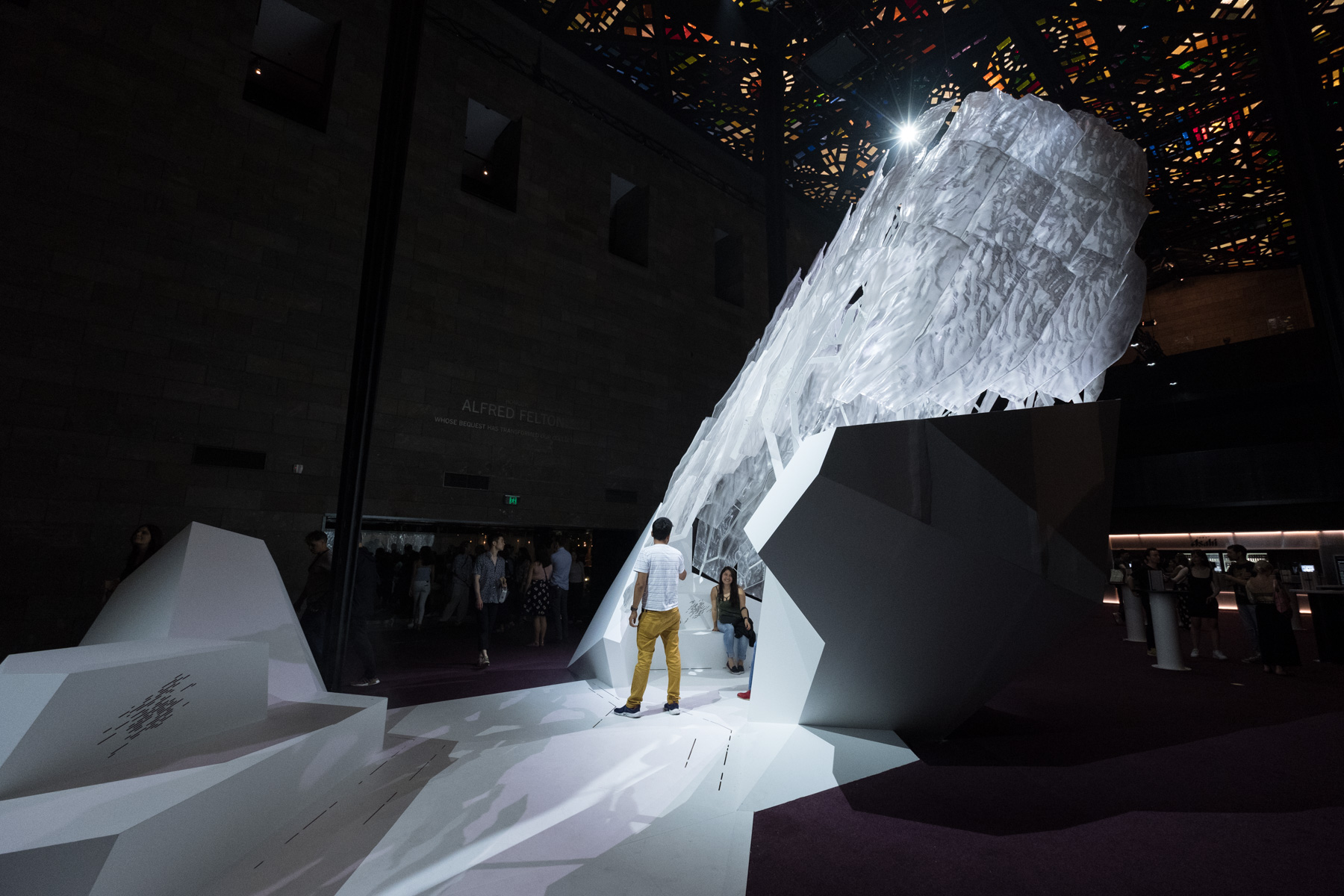
Transporting audiences visually and aurally to Antarctica, Floe 2018, draws on the atmospheric effects of the Antarctic landscape to create a speculative architectural installation designed in response to a sound work by Philip Samartzis. The architecture is a part of a larger body of work developed by Roland Snooks, director of the RMIT Architectural Robotics Lab, that explores the architectural implications of algorithmic design through robotic 3D fabrication. The translucent skin of the tower comprises seventy unique overlapping semi-clear polymer panels printed by robot.
The sound work was recorded by Samartzis in Antarctica. By recording and representing the many sounds of Antarctica’s constantly shifting ice shelves, glaciers, icebergs and sea ice, Samartzis challenges the perception of Antarctica as an unchanging landscape, suspended in time and place.
- Design Partner: Installation supported by RMIT University.
- Sound work supported by the Australian Antarctic Division, the Australia Council for the Arts, the Bogong Centre for Sound Culture, Creative Victoria and RMIT University School of Art.
NGV Video Link to the making of FLOE
Super Field
Super Field is an immersive sonic and visual exhibition that highlights the work of Australian and international artists engaging with remote regions and their communities. In these places reside marginalised or displaced communities, extreme climate, endangered wilderness, and the corrosive effects of industrialisation. The works respond to a complex set of social, economic, political and environmental issues to deepen understanding of these places and their communities.
High Country:
The Australian Alps
8–22 Dec. 2017
- Benoit Bories [FR]
- Jay-Dea Lopez [AU]
- Philip Samartzis [AU]
- Michael Vorfeld [DE]
- Matthew Berka [AU]
- Madelynne Cornish [AU]
- Matthew Quomi [AU]
A Surrender to Nature:
The Kimberley
16–20 Jan. 2018
- Philip Samartzis [AU]
- Madelynne Cornish [AU]
Glacial Erratic:
Antarctica and the Arctic
23 Jan. – 3 Feb. 2018
- Natasha Barrett [UK]
- Lawrence English [AU]
- Douglas Quin [US]
- Philip Samartzis [AU]
- Jana Winderen [NO]
- Anne Colomes [FR]
- Madelynne Cornish [AU]
- Polly Stanton [AU]
Unheard Spaces:
International Wilderness Areas
6–17 Feb. 2018
- Yannick Dauby [TW]
- Hughes Germain [FR]
- Martin Kay [AU]
- Slavek Kwi (Artificial Memory Trace) [IE]
- Douglas Quin [US]
- Philip Samartzis [AU]
- Chris Watson [UK]
- David Burrows [AU]
- Madelynne Cornish [AU]
Super Field provides audiences with an immersive encounter of a wide selection of environments using 40 loudspeakers and an array of projected images dispersed throughout the gallery. Audiences will be encouraged to wander through the field of loudspeakers and projected images as they would a forest, navigating densities of space and discrete zones of aural and visual experience.
Super Field provides a platform to enable artists, researchers, scholars and curators to engage with contemporary global concerns to enhance understanding of remote ecologies. By provoking new ways of hearing and of seeing these spaces, such artworks can encourage a deeper sense of appreciation and advocacy for the places captured within them, and prompt us to hear and see other places – both foreign and familiar – anew.
Writers
- Dr Ben Byrne
- Dr Carolyn Philpott
- Dr Leandro Pisano
- Dr Kristen Sharp
Super Field is presented by RMIT Design Hub and Bogong Centre for Sound Culture. For more information please refer to RMIT Design Hub
Supported By
Benoit Bories is supported by the Institut Français, Municipality of Toulouse and the Alliance Française in Australia.

A Surrender to Wind in 9 Parts
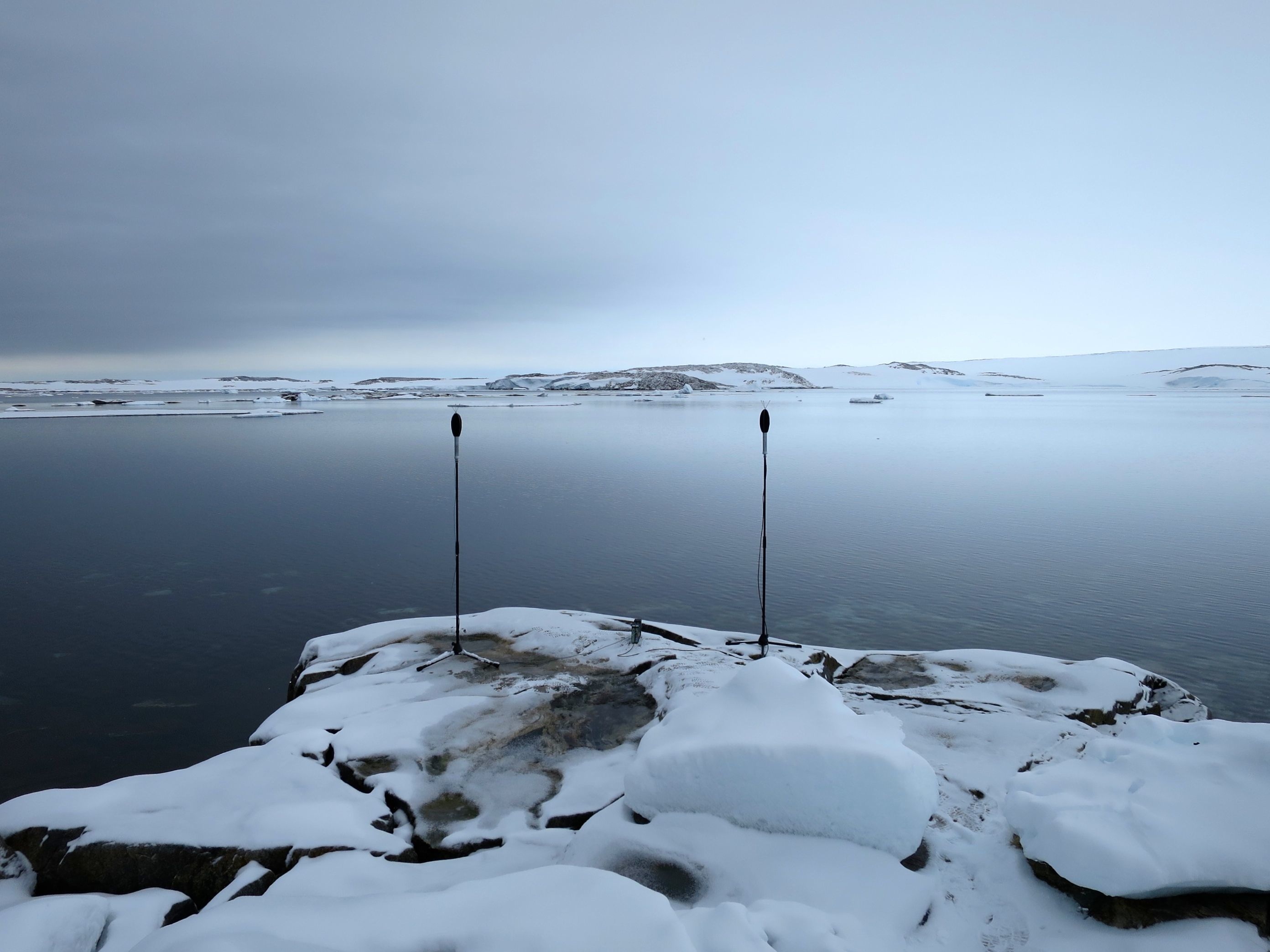
What is wind and how does it shape the way we listen? This program commissioned by France Culture examines the nature and impact of wind upon some of the most remote parts of the world. It reveals the intensity of an Antarctic blizzard, the sound of drought in the South Australian wilderness, and the effects of wildfire in the Kimberley. It explores the transformative quality of wind to convey new knowledge and experience of the natural and built environment and their attendant communities. Through these recordings a hidden, dystopian history is revealed that connects the present to the future.
Listen here to A Surrender to Wind in 9 Parts
Sonic Interventions

Sonic Interventions is a collaborative sound art project curated by Madelynne Cornish [AU] and Daniel Lercher [AT]. The project is designed to highlight a diverse range of environmental sound practices emanating from Australia and Austria. The exhibition features the works of 14 contemporary sound artists and composers who investigate the relationship between the natural and constructed environment.
The multifaceted exhibition takes place at Kultur Drogerie in Vienna. It includes compositions for headphone listening, live performances, and artist talks. Additionally the main gallery window will be transformed into a loudspeaker to spatialise a special sound mix for public space whereby composed sounds converge with the urban soundscape.
What is place?
Sonic Interventions is a transnational collaboration investigating the nature and representation of place. It uses the framework of sound art and experimental composition to interrogate the social, material and environmental ecologies of natural and manufactured landscapes, objects and spaces. The project comprises a listening program where place is rendered through various recording techniques, activated by performed gestures, and transformed through abstraction and process. The program explores a diverse range of themes including the effects of weather and industrialisation, social and environmental observations, and the transfiguration of the natural world. Together they communicate different ways place can be constructed and experienced, evoking a deeply mysterious world of actions, flows, energy and rupture. Situated within an exhibition context, these compositions are conceived for close listening within a localised setting, and as source material for incursion into public space. The articulation of sound works into the public realm provides an opportunity to recalibrate the experience of the urban soundscape. A place where real and imaginary spaces and encounters converge.
Performances
- DANIEL LERCHER: Friday 10 June
- PETER KUTIN: Friday 24 June
- doors open 7pm
- live performance 8.30pm
Exhibition
- Sound installation in public space:
- every day from 7:00h - 22:00h
- Inside listing stations:
- Mo. - Fr. 17:00h - 19:00h
Sonic Interventions CD
This dual disc audio publication features the exhibition's compositions, a 16pp booklet with text from each artist and a short essay by Philip Samartzis contextualizing the exhibition.
- Produced in-house on Risograph RP-30
- Limited edition of 150 copies
- Cost $20 + postage
- purchase here

